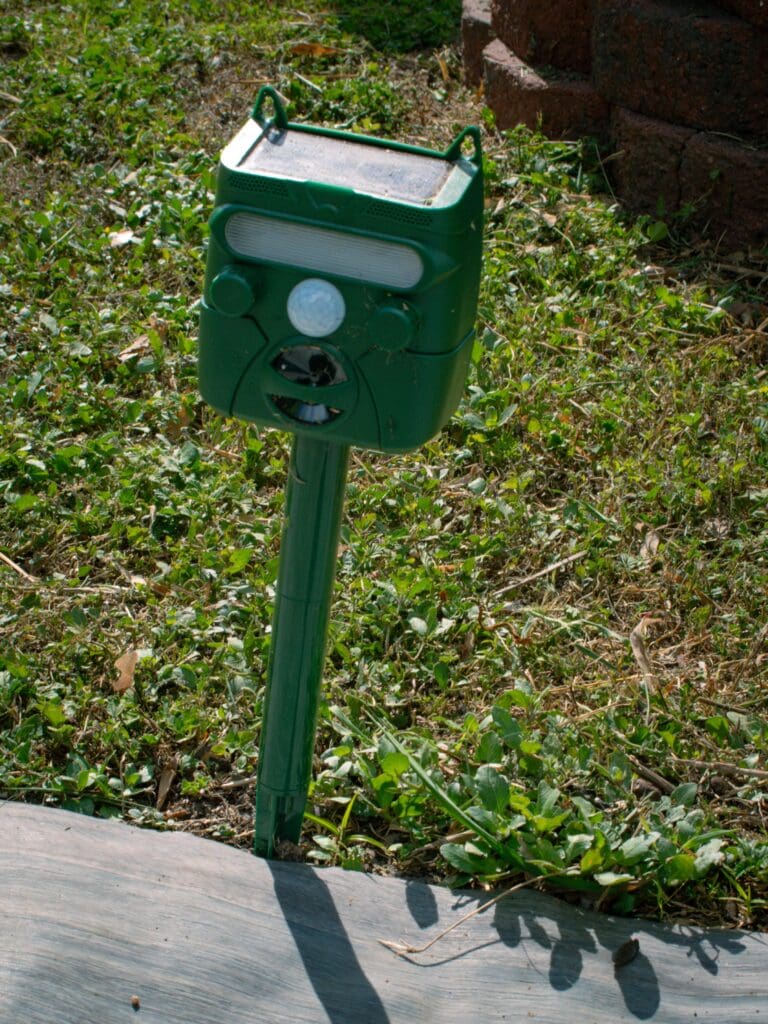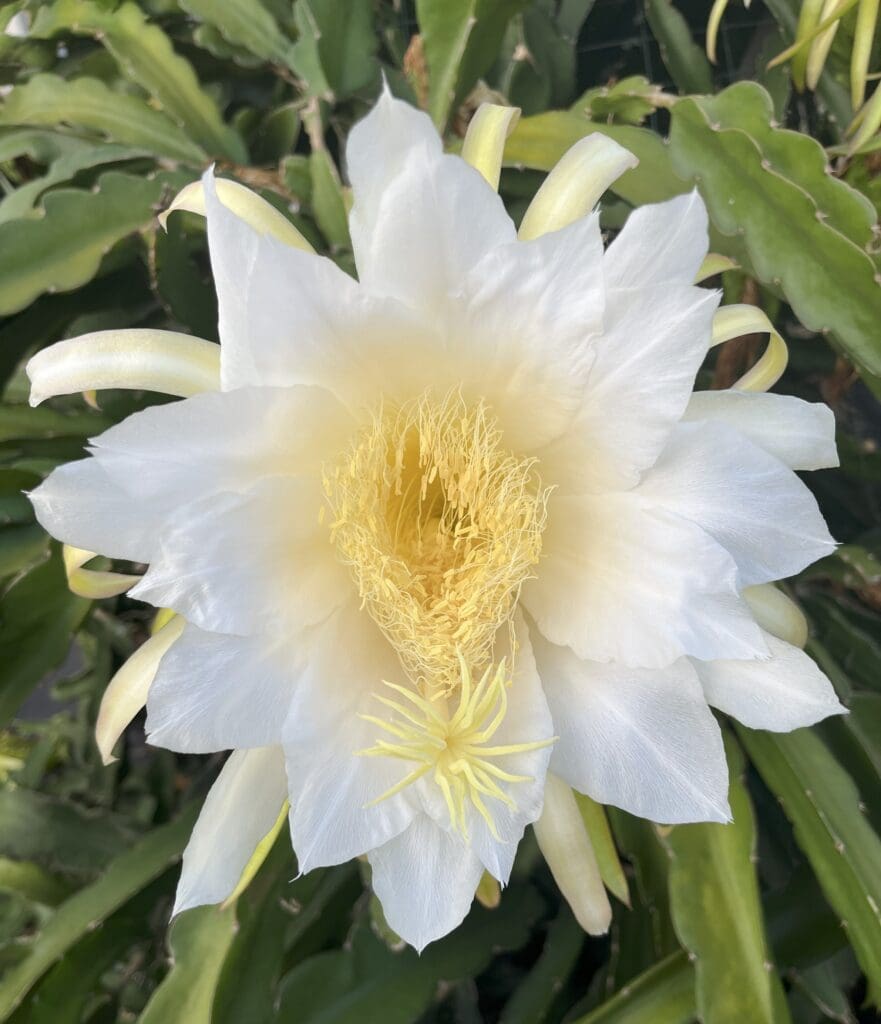Some of you may know Kevin – he’s one of Gill’s Landscape Crew Leaders. He’s been a valuable member of the team since 2008, and he’s completed thousands of beautiful landscape projects over the years. He’s known around here as a landscape construction expert and a man of few words, unless you get him talking about plants…especially his incredible dragon fruit cacti! Kevin’s been growing and propagating dragon fruit in his backyard for 15+ years, and he gets about 75lbs of the most delicious fruit every season. You can too! Here are Kevin’s tips for how to grow the best dragon fruit in Corpus Christi and beyond.
Soil Prep & Fertilizer
Dragon fruit cacti are epiphytes, meaning they grow onto trees and other plants in nature, and they can climb using aerial roots. With that in mind, you can guess that if they are planted in soil, they prefer a loose, well-drained mix. Our Corpus Christi clay soil is far from loose or well-drained, but it can certainly be achieved. Kevin uses a mixture of both Nature’s Blend and Cotton Burr compost, along with some Expanded Shale to heavily amend the native clay soil before planting to add nutrients and create looseness for roots to grow into. He also advises planting high so water will naturally run away from the plants to prevent fungal issues. A few months before flowers start to arrive in June, Kevin begins fertilizing with a blend of organic Medina Growin Green and Rose Glo once a month, followed by liquid Hasta Gro every 2 weeks.

Sunlight & Water Requirements
Dragon fruit cacti can grow in more shade than you might think. Kevin says he’d prefer if his got more afternoon shade, but they do well in his mostly sunny backyard. He’s got drip tube irrigation installed around both of his big trellises, but he says he uses it very sparingly if at all. When planted, the cacti need good deep watering for 1-2 months to get established, then very little thereafter. As your cacti grow, they’re also easy to propagate from cuttings. Kevin uses 3 gallon size recycled nursery pots filled with loose potting soil to start new cuttings. After about 6 months in their pot, they’re nice and well-rooted and ready to move to a permanent home in the ground.

Sturdy Trellis Structure + Good Cross-Pollination
Dragon fruit cacti grow fast and big and heavy. They need something solid to climb on that can support a lot of weight, like Kevin’s 4×4 frame and 2×2 lattice structure. Some gardeners like growing individual dragon fruit cacti on a single pole or post, but Kevin prefers growing several plants on a larger trellis. One of his best tips for getting more fruit is to plant different dragon fruit varieties next to each other on the same trellis to encourage better cross-pollination. On each of his trellises, Kevin’s got 3 different dragon fruit varieties that have all grown together and intertwined – more flowers and more fruit!

Watch Out for Possums!
Possums are not bad to have around, but apparently they love dragon fruit as much as we do. This year, Kevin tried something new that has proven to be very effective for keeping possums away from his fruit: a simple ultrasonic pest repeller. He’s got several of the units that he purchased inexpensively online, placed around his cacti. They’re motion activated, so when a possum strolls by, they flash a light and emit an ultrasonic frequency that the possum can’t stand. The units have different settings for other rodents, cats, dogs, etc. We can’t speak to their effectiveness for other critters, but they seem to be working well against possums.

Bees in the Morning + Moths at Night
Speaking of flowers, dragon fruit blooms at night. As the blooms emerge at dusk and into the night, they attract all kinds of cool moths. Then, in the early morning, the bees get their turn. The dragon fruit flowers are an awesome source of nectar for moths and bees, who do their work pollinating the flowers to produce more fruit. Take a look at these blooms!


Protect From Freezes!
Yes, dragon fruit cacti will freeze, but they can be protected with great success. Both of Kevin’s huge 15 year old cacti made it through the big freeze in 2021. During freezing weather, Kevin uses a big tarp to make a tent all the way over the whole trellis, all the way to the ground, then uses large stones to weight it down. He also uses low-voltage reptile heat lamps under the tarp for extra heat. The day the weather warmed up and the sun came back out after the 2021 freeze, Kevin pulled back the tarp to find a big bloom – in no time it was covered with hungry bees.

Enjoy Your Delicious Fruit!
If you’ve never tasted fresh dragon fruit aka pitaya, you’re in for a real treat. The fruit has a similar texture to a kiwi, but softer and no tartness. It’s smooth and sweet. Plus it’s packed with antioxidants and vitamins. Even though it tastes sweet, it actually contains relatively low sugar and is considered a low-glycemic-index food. Kevin likes to cut them in half and eat with a spoon, or add to refreshing smoothies and drinks. He even makes a dragon fruit custard pie!





Sallu Gill says
Go Kevin! Thanks so much for the detail info on successfully growing dragonfruit. I bet there will be many new dragonfruit plants growing thanks to the blog!
James Gill says
Wow, impressive knowledge well presented, with great pictures. Thanks!